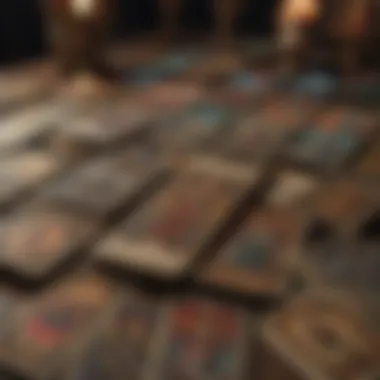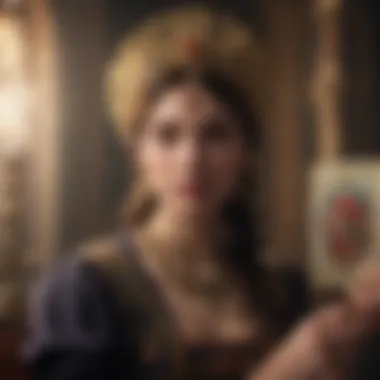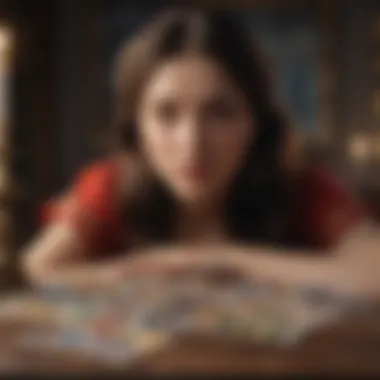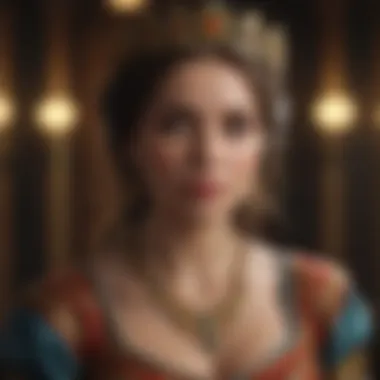Exploring Free Tarot: Insights and Ethical Practices


Intro
The field of tarot offers a unique portal into self-reflection and personal insight. As many seek ways to enhance their lives, free tarot readings have emerged as a valuable tool. This guide will help you unravel the complexities of tarot, showcasing its historical context, methodologies, and significant ethical considerations. The aim is to provide a thorough understanding of how one can engage with free tarot readings effectively.
Zodiac Sign Overview
General Traits
Each zodiac sign embodies distinct characteristics, influencing personality and life choices. The twelve signs form a cycle, each representing unique energies and traits, impacting various aspects of our lives. Understanding these traits is crucial for deepening one's tarot reading experience.
Element and Modality
Each sign belongs to one of four elements: earth, air, fire, or water. Furthermore, modality plays a role in categorizing signs into cardinal, fixed, or mutable. This classification sheds light on how each sign interacts with the world, which can inform tarot interpretations.
Strengths and Weaknesses
Understanding the strengths and weaknesses of each zodiac sign can enhance intuition during tarot readings. For example, Aries may possess courage but can also be impulsive. In contrast, Taurus may show determination but risk becoming stubborn. These attributes can reflect in the cards drawn and the messages conveyed.
Detailed Horoscope Analysis
Daily Horoscope Breakdown
A daily horoscope serves as a guide, offering insights based on the current positions of celestial bodies. Free online resources provide these daily updates, making it easier to access information that aligns with personal journey through tarot.
Weekly and Monthly Predictions
Weekly and monthly horoscopes aid individuals in seeing the bigger picture. Regular readings can provide guidance during transitions and challenges, helping align actions with astrological influences.
Key Planetary Influences
Understanding planetary movements and their impacts is vital for comprehensive tarot readings. Specific transits may trigger certain traits within each zodiac sign, enabling deeper interpretations of the tarot cards drawn.
Astrology for Personal Growth
Understanding Birth Charts
A birth chart, or natal chart, is a map of the sky at the time of one's birth, providing critical information about personal strengths and weaknesses. This foundational knowledge allows for more nuanced tarot readings.
Tips for Embracing One's Zodiac Traits
Understanding one’s zodiac traits helps navigate life challenges and encourages personal growth. Tarot can play a supportive role in this journey, offering clarity and direction during moments of confusion.
Astrological Practices to Enhance Life
Integrating astrology with daily practices can improve overall well-being. Consider using tarot alongside meditation, journaling, or other mindfulness practices to foster a deeper understanding of self.
As you explore the world of free tarot, remember that knowledge is not just power; it is also a road to personal insight.
This guide intends to demystify free tarot reading and empower you with the understanding necessary for meaningful exploration. Remember to approach tarot with curiosity and openness, as it may reveal profound insights into your personal life.
Understanding Tarot
Understanding Tarot is crucial for those exploring its depths. As an ancient divination system, its practices and meanings offer a pathway to self-discovery and insight.**** Many individuals seek tarot as a means to reflect on life events, relationships, and personal growth. This section provides foundational knowledge crucial for utilizing tarot effectively.
The History of Tarot


The history of tarot is both complex and fascinating. It can be traced back to 15th century Europe, initially as a card game known as tarocchi. The use of tarot for divination emerged later, gaining prominence in the 18th century. Scholars such as Antoine Court de Gébelin believed tarot cards held ancient Egyptian wisdom, though this claim lacks substantial evidence. Such misconceptions led to an esoteric interpretation of tarot, positioning it as a tool for mysticism rather than just a game.
Throughout history, various tarot decks were created, notably the Visconti-Sforza deck in Italy and the Rider-Waite deck developed in the early 20th century. Each deck's imagery and symbolism reflect cultural contexts and beliefs. Card meanings evolved, often influenced by spiritual movements, making tarot a rich blend of art, psychology, and esotericism. Understanding this history allows practitioners to appreciate the cards' evolution and the depth of their meanings.
The Composition of Tarot Decks
A tarot deck typically consists of 78 cards. These are divided into two main sections: the Major Arcana and the Minor Arcana. The Major Arcana includes 22 cards that represent significant life events and spiritual lessons. Each card, from The Fool to The World, carries profound symbolism, capturing archetypal themes.
The Minor Arcana, on the other hand, comprises 56 cards divided into four suits: Cups, Pentacles, Swords, and Wands. Each suit relates to different aspects of life such as emotions, material aspects, intellect, and creativity. Within this structure, each card depicts specific situations or challenges one may experience.
To understand a tarot deck fully, certain elements should be noted:
- Imagery: Each card's illustration plays a role in interpretation. Colors, symbols, and figures contribute to the overall message.
- Numerology: Numbers associated with the cards have additional meanings, enriching interpretations.
- Suit Associations: Knowing what each suit represents enhances reading depth.
The Mechanics of Tarot Reading
The study of tarot is not merely about card meanings but also involves the intricate mechanics that govern how readings are conducted. Understanding these mechanics is essential for anyone looking to delve into tarot readings, whether for personal insight or to assist others. This section explores the fundamental elements and benefits of tarot reading, as well as significant considerations one should take into account.
Understanding the Major Arcana
The Major Arcana consists of 22 cards and holds significant weight in any tarot reading. Each card represents profound archetypal themes that reflect overarching life lessons and experiences. Understanding these cards is crucial for interpreting the deeper messages that tarot can provide. When the Major Arcana cards appear in a reading, they often indicate a critical moment in the querent's life, highlighting major influences at play.
Some key cards include:
- The Fool: Represents new beginnings and adventures.
- The Tower: Symbolizes destruction and upheaval, leading to new perspectives.
- The World: Denotes completion and fulfillment.
Readers often prompt deeper contemplation with the Major Arcana, connecting personal experiences to the broader human condition. This allows for a more profound exploration of self.
Exploring the Minor Arcana
The Minor Arcana complements the Major Arcana by focusing on everyday situations and challenges. It consists of 56 cards divided into four suits: Cups, Pentacles, Swords, and Wands. Each suit covers distinct aspects of life, from emotions and relationships with Cups to ambitions and challenges with Wands.
The Minor Arcana cards give insights into the daily experiences and interactions of the querent. For example, drawing a card from the Cups may suggest emotional scenarios, while Pentacles often align with material and financial matters. Key cards include:
- Ace of Cups: Opens up new emotional possibilities.
- Five of Swords: Indicates conflict and challenges.
- Ten of Pentacles: Reflects inheritance and wealth.
Understanding both Major and Minor Arcana enriches the reading process. Each card serves as a tool, guiding the reader and querent towards clarity and insight into the questions posed.
Why Choose Free Tarot Readings?
The appeal of free tarot readings cannot be overstated in today's world, where access to personal growth tools is crucial. Many individuals seek clarity and direction during tumultuous times. Free tarot readings provide a valuable resource for those who may not wish to invest financially. This section delves into the benefits of choosing free tarot, emphasizing aspects such as cost-effectiveness and accessibility, as well as the potential for self-reflection.
Cost-Effectiveness and Accessibility
One of the most compelling reasons to choose free tarot readings is their affordability. Financial constraints can limit access to various services, including tarot. Online platforms, mobile apps, and community-driven sites offer free resources that allow anyone to explore tarot without the pressure of costs. This enhances inclusivity, making tarot an accessible practice for all.
- Diverse Platforms: Numerous websites and applications provide free readings ranging from basic one-card pulls to elaborate spreads.
- Community Engagement: Many online forums encourage users to exchange insights, fostering a sense of belonging among tarot enthusiasts.
- Learning Opportunity: Beginners can practice and hone their skills without the financial risk, developing gradually through experience.
By removing financial barriers, free tarot opens up opportunities for many to engage with this introspective art form.
A Tool for Self-Reflection
Free tarot readings serve as a powerful tool for self-reflection. They encourage individuals to pause and contemplate their current situations. Engaging with the cards can prompt insights into one’s thoughts, emotions, and behavior patterns. It enables a deeper understanding of oneself, guiding personal development.
- Personal Accountability: The process encourages honest self-assessment. Users often report feeling more aware of their choices and responsibilities after a reading.
- Clarifying Intuition: Free tarot can help clarify intuitions that may be obscured by day-to-day chaos. Through this lens, users learn to trust their instincts.
- Exploration of Emotions: Tarot tap into hidden feelings or concerns, providing a space for emotional release and clarity.


This reflective practice can reveal aspects of oneself that are often overlooked, fostering growth and understanding.
Types of Tarot Spreads
The significance of tarot spreads cannot be understated in the practice of tarot reading. A spread refers to the arrangement of cards drawn during a reading, serving as the foundation that determines the direction of the session. Different spreads yield various insights and cater to specific queries. Understanding the types of spreads available, their unique benefits, and considerations can enrich a reader's experience. Each kind of spread can provide layered meanings and a depth of interpretation, making it essential for both beginners and advanced practitioners alike.
Single Card Draws
Single card draws are the most straightforward and simple form of tarot reading. This method is ideal for those seeking quick insights or guidance on a specific question or situation. The strength of this approach lies in its immediacy and clarity. When you draw a single card, it becomes a focal point for introspection, prompting a reflection on its meaning in relation to your query.
This technique can be useful for daily readings, where individuals might ask a question like, "What should I focus on today?" By concentrating on one card, the reader can easily interpret its symbolism and apply that understanding to their day-to-day life. While single card draws yield limited insights compared to more complex methods, they can serve as a valuable entry point into deeper tarot exploration.
Three-Card Spreads
Three-card spreads build upon the simplicity of a single card draw by adding layers of context and complexity. Typically, the cards represent the past, present, and future. This format allows the reader to analyze how events or influences from the past are impacting the current situation and how they may affect future outcomes. Each card contributes a piece of the overall narrative, promoting a more comprehensive understanding of the subject matter.
Additionally, three-card spreads can be tailored based on the reader's specific needs. For example, the cards can represent different aspects such as mind, body, and spirit or even specific areas like love, career, and personal growth. The versatility and depth provided by this format make it a popular choice among tarot enthusiasts. As a result, three-card spreads are appreciated for their balance between simplicity and depth, offering valuable insights for those seeking guidance in various life situations.
Celtic Cross Spread
The Celtic Cross Spread is one of the most well-known and detailed tarot spreads. It consists of ten cards arranged in a specific pattern, designed to provide deep insights into the querent’s life, challenges, and potential outcomes. This spread covers various aspects of those challenges, including underlying influences, obstacles, and external factors at play.
Each position in the Celtic Cross has a specific meaning, which helps the reader develop a structured narrative. In this way, the spread allows for a nuanced exploration of complex situations. For those looking for comprehensive guidance, the Celtic Cross can intricately reveal the intertwining influences affecting their lives.
It's important to note that mastering this spread requires practice, as interpretation can be intricate. This depth can be both a strength and a potential drawback. Ensuring card positions are correctly understood can lead to a richer reading experience. Overall, the Celtic Cross Spread exemplifies the depth of tarot, inviting an exploration of life’s multifaceted nature in a structured yet meaningful way.
Intuition is where the magic happens in tarot; each reading can unveil unique insights based on the interplay of cards and the reader’s inner voice.
Digital Resources for Free Tarot
The digital age has transformed many aspects of our lives, including how we access and engage with tarot. Digital resources for free tarot have made this ancient practice more accessible to a broader audience. With just a smartphone or computer, anyone can explore tarot without the need for physical decks or costly readings. This section will cover the importance of digital resources, emphasizing their benefits, usability, and some notable platforms available today.
Mobile Apps and Online Platforms
Mobile apps and online platforms provide users with diverse opportunities to interact with tarot. They allow for flexibility in accessing tarot readings on demand. Many apps also feature tutorials that can assist beginners in understanding card meanings and their interpretations. Additionally, they allow users to customize their readings, choosing different spreads according to their needs.
Some powerful apps include:
- Labyrinthos: This app is designed specifically for tarot. It offers guided readings and explanations for each card, making learning easy.
- Tarot Strangers: A platform where users can connect with tarot readers for live readings. It's an excellent way to gain insights from experienced practitioners.
- Golden Thread Tarot: This app supports beginners with a structured learning path while also offering card meanings and spreads.
With the increasing popularity of mobile devices, having tarot at one's fingertips has made the practice more inclusive. Users can delve into tarot anywhere, whether during their commute or at home.
Free Online Tarot Services
Various free online tarot services allow users to engage without any financial commitment. These websites host a variety of tarot options, including automated readings and guided interpretations. Most platforms offer simple features, enabling users to draw cards and receive interpretations instantly.
Prominent free tarot services include:
- Biddy Tarot: This resource offers free tarot readings, comprehensive guidebooks, and articles about card meanings and spreads.
- Tarot.com: A well-known site providing free daily tarot readings and in-depth articles about tarot history and techniques.
- Facade: This platform offers automated tarot readings with extensive card explanations, enhancing user insights.
One key benefit of these free services is that they encourage users to cultivate their understanding and intuition without the pressure of cost. Users can experiment with different spreads and interpretations, deepening their connection to the tarot.
Remember, while digital resources are convenient and useful, they should serve as a complement to personal reflection and study rather than a sole resource for practice.
Ethical Considerations in Tarot Reading


Tarot reading is not merely a tool for divination; it carries a weight of responsibility and ethical considerations that readers must navigate. Understanding these ethical elements is essential for anyone involved in tarot practice, whether they are practitioners or those seeking guidance. This segment highlights the importance of ethical considerations like respecting the querent and avoiding dependency, providing insight into the reader's duty towards those they serve.
Respecting the Querent
Respecting the querent, or the individual seeking a tarot reading, is paramount in any ethical practice. A reader must foster a safe and supportive environment for the querent. This not only enhances the experience but also promotes honest and open communication.
It is vital to remain non-judgmental. Every querent comes with their own background, experiences, and emotional baggage. The tarot reader must approach each session with empathy and an understanding of the querent's unique situation. This creates trust and facilitates a more meaningful connection between the reader and the querent.
Additionally, confidentiality is a crucial aspect of respecting the querent. Sensitive information shared during a reading should remain private. Readers should make it clear that personal details will not be disclosed without consent. This assurance encourages querents to share their concerns more openly, leading to more insightful readings.
Moreover, readers must set clear boundaries around the type of guidance they offer. Making it explicit that tarot readings do not replace professional advice, such as legal, medical, or psychological counsel, is essential. This helps in preventing the querent from misplacing their trust and relying solely on tarot for significant life decisions.
Avoiding Dependency
Avoiding dependency is another critical ethical consideration in tarot reading. Readers must be aware of the potential for querents to become overly reliant on tarot readings for decision-making. Establishing a healthy dynamic means helping querents use tarot as a tool for introspection rather than a crutch for their decisions.
Educating querents about the nature of tarot is fundamental. It should be framed as a means for self-reflection and alternative perspectives, not as a definitive answer to life’s challenges. This approach empowers querents, encouraging them to trust their judgment while recognizing tarot as a valuable, yet supplementary tool.
Furthermore, readers should remain alert to signs of dependency in querents. If a querent returns excessively seeking advice for every small issue, it may indicate a reliance that should be addressed. Gently reminding them of their own power and agency in decision-making can be beneficial.
In summary, ethical considerations in tarot reading, such as respecting the querent and avoiding dependency, are crucial for fostering a healthy practice. Tarot readers should strive to create a responsible and empowering environment that encourages self-reflection and personal growth. This approach not only enhances the experience for the querent but also enriches the reader’s practice, making it ultimately more meaningful.
The Future of Tarot in the Digital Age
The integration of tarot practice within the digital landscape opens new horizons for enthusiasts. Significantly, it enhances accessibility and diversity in readings and resources. Digital platforms facilitate more personal experiences, allowing users to engage with tarot in a way that was previously limited to in-person encounters. Additionally, they provide opportunities for broader knowledge sharing and community engagement, shaping the future of tarot reading.
Virtual and Augmented Reality Experiences
Virtual and augmented reality are altering how tarot can be experienced. With VR, a user can step into a digital space resembling a mystical environment, immersing themselves in the ambiance of a traditional tarot reading. This experience can contribute to a deeper connection with the cards and boost intuition by creating a fully sensory ritual.
Augmented reality also offers interactive elements, where users can see cards come to life via their smartphones or tablets. This blend allows tarot readings to move from the page or screen into a more engaging format. Such technology enables tarot practitioners of all levels to explore cards and their meanings with newfound depth and enjoyment.
- Enhanced immersion
- Comprehensive educational tools
- Customizable reading environments
With easy access to these technologies, tarot’s reach will likely expand, attracting new users and fostering an inclusive community where everyone can explore and grow.
Community Building Through Online Forums
Online forums have become essential for the evolution of tarot communities. Platforms such as Reddit and Facebook provide spaces where individuals can share experiences, advice, and interpretations. Engaging in these discussions fosters learning and creates a sense of belonging among users.
Through these forums, individuals often share tarot spreads, insights, and even personal stories related to their readings. This sharing can lead to intricate discussions, allowing a greater understanding of both tarot's complexity and its transformational power.
- Local and global connections
- Peer support and mentorship
- Resource sharing
Building an online community around tarot is crucial for fostering connections and encouraging growth. As users continue to seek and share insights, the depth of understanding and appreciation for tarot will likely flourish in the digital age.
“In a world where connection is often digital, online tarot forums unite enthusiasts to share the wisdom of the cards.”
End
Free tarot readings serve as a gateway for personal discovery and growth. They encapsulate a myriad of insights about one's life path, aspirations, and challenges. Engaging with tarot allows individuals to explore deeper introspective inquiries that might otherwise remain unexamined. The beauty of free tarot lies in its accessibility.
The Value of Free Tarot in Personal Development
Utilizing free tarot within one’s personal development journey fosters a sense of agency and empowerment. It encourages individuals to actively engage with their life circumstances and emotions. Through tarot, users can gain clarity about their decisions and life experiences. Here are some significant aspects worth considering:
- Self-Reflection: Tarot promotes reflective thinking. It pushes individuals to contemplate their situations, often highlighting aspects that need attention.
- Insight into Emotions: The cards can mirror emotional states and relationships, guiding users to better understand their feelings and the motivations of others.
- Flexibility in Interpretation: Each card can hold multiple meanings depending on the context. This versatility encourages users to explore different perspectives on their challenges.
- Building Intuition: Engaging regularly with tarot nurtures one’s intuitive capabilities, helping in decision-making processes in real life.
The role of free tarot in personal development cannot be overstated. Not only does it provide a tool for insight, but it also creates a space for dialogue within oneself. User engagement with tarot can yield profound personal revelations. Such moments can lead to practical changes, making tarot a valuable instrument in one’s journey toward self-awareness and personal growth.
"Tarot is not just about predicting the future; it’s about understanding the present."







